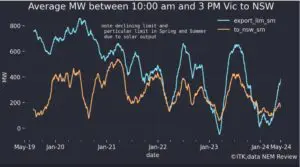“Perfection is the enemy of the good”
Voltaire
COGATI process continues regardless
Nothing, it seems, can stop the COGATI process or the introduction of Financial Transmission Rights: Not the fact that they are of no assistance to transmission planning, not the opposition of significant parts of the industry, not the Covid-19 virus and least of all the fact that the actual state of the transmission system means that neither the buyer nor the seller of such rights is necessarily buying anything worth the paper it’s written on.
Consider the issues with system strength both in “the rhombus of regret” and in North Queensland. In both those regions due to no fault (so to speak) of either the transmission system nor the impacted generators, there has been a reduction in allowable transmission capacity.
It’s an after-the-fact act, that is after the generators have satisfied all requirements at the time to be allowed to generate, and yet it kills the equity return to those generators.
A financial transmission right would, therefore, most likely be a win mainly for the legal industry. Both the seller and the buyer could legitimately claim it wasn’t their responsibility. I guess a properly drafted legal agreement would cover it.
The bigger issue, to my mind, is that the transmission system is a mess and that creating more markets should not be the main priority.
As we noted recently, as well as the actual lack of plain old transmission capacity, the emerging issue is that control of the transmission and distribution system is gong to change radically over the next 20 years.
The need for reactive power, for inertia-less frequency and voltage control is perhaps where a market could be created. It would be helpful, perhaps, if there was an incentive for new wind and solar farms to be fitted with inverters that provided such services if there was a market for reactive power perhaps DC transmission would be taken more seriously. I’ll be the first to admit these are just thought bubbles but it’s not clear to me that the AEMC still really embraces its fundamental job.
What does seem to be clear is that the AEMC is fighting a turf war for control of the rule making process. This diagram published by the AEMC yesterday sets out its view of how the “prize” is to be carved up.

I’m not going to comment much on the NERA economic benefits review of other markets study, except to say that the study indicates that there is uncertainty both about the costs and the benefits. The evidence on implementation costs is particularly soft and not unexpectedly the strong suspicion is that actual costs are materially higher than estimated costs.
It’s a complicated area and I guess I should be careful about jumping to conclusions. However, my personal view remains that this process is likely to prove a distraction to the real job.
The real job is designing a transmission and control system for a largely decarbonised grid. Understanding the balance between distributed and utility-scale systems, making sure that enough transmission and the right sort of transmission is available to REZs (renewable energy zones); making sure the REZs are the right REZs.
In short, COGATI is going to get in the way of the ISP (Integrated System Plan) and the ESB (Energy Security Board) and the work on control of the system that the ESB has yet to even mandate.










